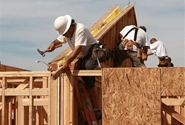Steel Markets

Single-Family Starts Decline in November on Affordability Concerns
Written by Tim Triplett
December 18, 2018
Rising housing affordability issues continue to hinder single-family construction even as total housing starts increased in November, reports the National Association of Home Builders.
 According to newly released data from the U.S. Department of Housing and Urban Development and the Commerce Department, overall housing starts rose 3.2 percent in November to a seasonally adjusted annual rate of 1.26 million units from a downwardly revised October reading. Year-to-date, new housing starts are 5.1 percent above their level over the same period last year.
According to newly released data from the U.S. Department of Housing and Urban Development and the Commerce Department, overall housing starts rose 3.2 percent in November to a seasonally adjusted annual rate of 1.26 million units from a downwardly revised October reading. Year-to-date, new housing starts are 5.1 percent above their level over the same period last year.
The November reading of 1.26 million is the number of housing units builders would start if they maintained this pace for the next 12 months. Within this overall number, single-family fell 4.6 percent to 824,000. Single-family production has now dropped for the third straight month. Meanwhile, multifamily starts—which include apartment buildings and condos—rose 22.4 percent to 432,000.
“The decline in single-family production over the last few months makes sense given the drop in our builder confidence index,” said NAHB Chairman Randy Noel, a custom home builder from LaPlace, La. “Builders are cautious to add inventory as housing affordability concerns are causing consumers to pause on making a home purchase.”
“Favorable demographics support healthy housing demand, so it is frustrating that the housing affordability crisis is preventing many consumers from achieving their goal of buying a home,” said NAHB Chief Economist Robert Dietz. “While homeownership has increased over the last nine quarters, we can expect that upward momentum to stop due to rising home costs. Because housing leads the economy, we need to stabilize residential market conditions.”
Overall permits—which are an indicator of future housing production—rose 5 percent in November to 1.39 million. Single-family permits inched up 0.1 percent to an 848,000-unit pace, while multifamily permits rose 14.8 percent to an annualized rate of 480,000.
Looking at the regional numbers on a year-to-date basis, combined single-family and multifamily housing starts rose 11 percent in the West and 5.3 percent in the South. Starts fell 0.8 percent in the Northeast and 1.9 percent in the Midwest.

Tim Triplett
Read more from Tim TriplettLatest in Steel Markets

CMC looks beyond Arizona micro-mill woes to long-term viability of construction mart
Despite the economic and geopolitical upheaval of the last five years, CMC President and CEO Peter Matt points out that the construction market has been an essential element of the way forward.

US importers face stricter rules under revamped S232 tariffs
“CBP expects full compliance from the trade community for accurate reporting and payment of the additional duties. CBP will take enforcement action on non-compliance," the agency said in a March 7 bulletin.

Steel exports rebound in January
US steel exports recovered to a five-month high in January after having fallen to a two-year low in December. This growth follows four consecutive months of declining exports.

Construction spending drops marginally in January
Construction spending edged down slightly in January, slipping for the first time in four months. The US Census Bureau estimated spending at a seasonally adjusted annual rate of $2,196 billion in January, down 0.2% from December’s downward revised rate. The January figure is 3.3% higher than a year ago. January’s result, despite the slight erosion, […]

HVAC equipment shipments slow in December but strong annually
Shipments of heating and cooling equipment in the US fell to an 11-month low in December, according to the latest data released by the Air-Conditioning, Heating, and Refrigeration Institute (AHRI).
